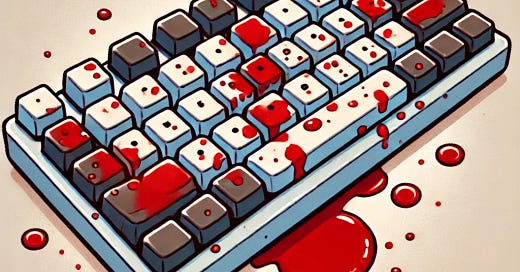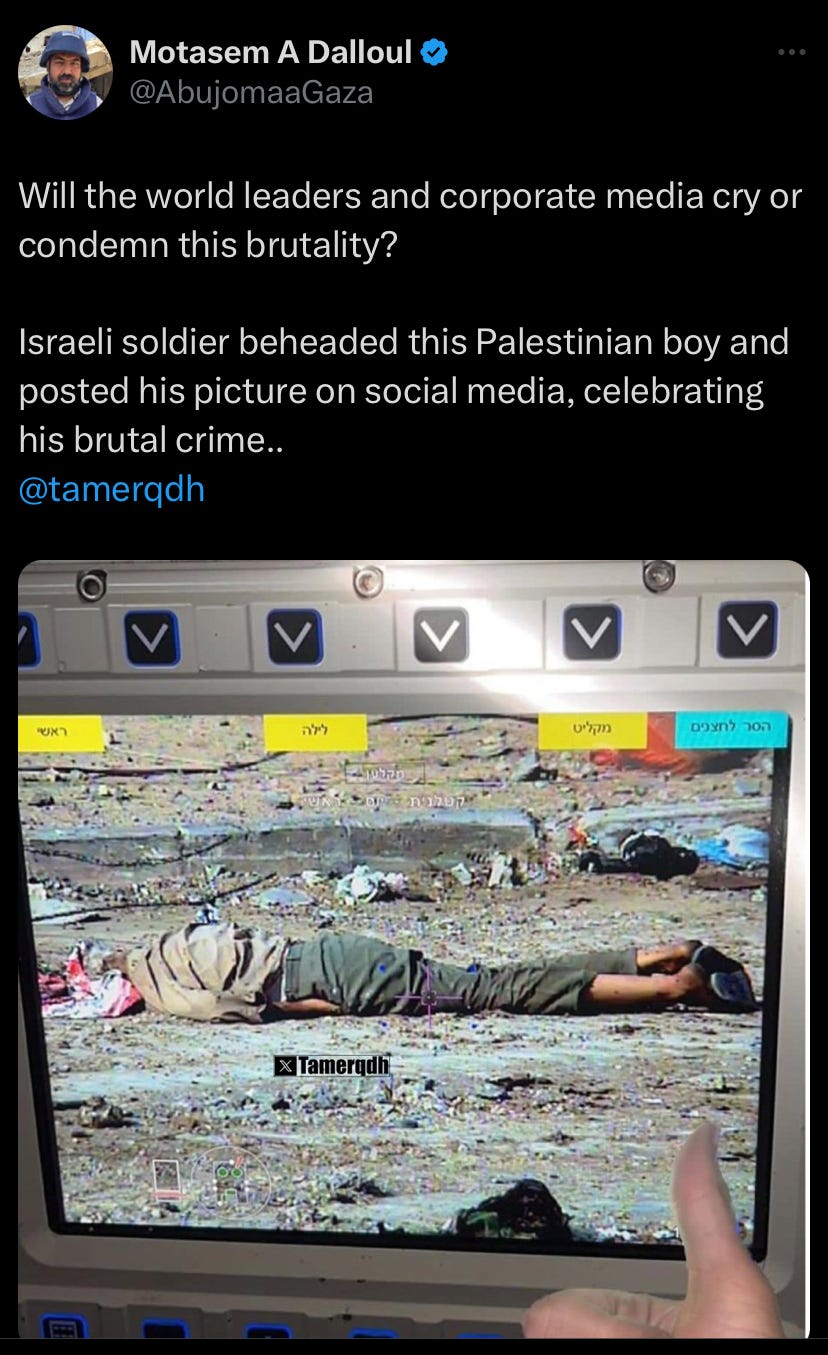Genocide Voyeurism Propaganda: How Genocidal Regimes Use Public Brutality as a Weapon
Public displays of atrocities are not just acts of cruelty—they are deliberate tools used to dehumanize, incite, and prove genocidal intent.
In recent history, acts of brutality committed in the context of occupation or conflict have been broadcast across social media, amplifying the horror for the world to see. These acts are not merely isolated incidents of violence but are often part of a much larger, insidious strategy: genocide voyeurism propaganda. One such example surfaced recently when an Israeli soldier posted a picture of a Palestinian boy he had beheaded on social media, celebrating the brutal crime. This is not an isolated case but rather an explicit signal of a broader genocidal strategy at play.
Publicizing violent acts in this manner is not just a crime of genocide—it is proof of the intent to commit genocide. This form of propaganda is used to dehumanize, incite further violence, and normalize brutality against the targeted group. Throughout history, genocidal regimes have used similar tactics to desensitize the public and encourage mass participation or passive acceptance of violence. By understanding the role of genocide voyeurism propaganda, we can more accurately recognize these events as clear signs of genocidal intent.
The Role of Genocide Voyeurism Propaganda
Genocide is not merely the act of mass killing. As defined by the United Nations Convention on the Prevention and Punishment of the Crime of Genocide, it includes acts committed with the intent to destroy, in whole or in part, a national, ethnical, racial, or religious group. These acts can include killings, causing serious bodily or mental harm, inflicting conditions designed to bring about the group’s destruction, and forcibly transferring children to another group.
While these acts are the physical manifestation of genocide, the propaganda that accompanies such actions is equally important in defining genocidal intent. Genocidal regimes do not operate in a vacuum. They rely on the dissemination of violence—both physically and psychologically—to legitimize their actions, justify atrocities, and incite the population to accept or participate in the eradication of a targeted group. This is where genocide voyeurism propaganda comes into play.
Genocide voyeurism propaganda refers to the deliberate public display of atrocities—often celebrated by the perpetrators—to incite further violence, normalize brutality, and dehumanize the victims. The act of sharing a beheading on social media is a modern manifestation of this tactic. It serves not only to intimidate and terrorize but also to rally supporters who view such acts as justifiable under the pretext of defense, power, or righteousness.
Proof of Genocidal Intent: Dehumanization and Incitement
The Israeli soldier’s act of posting the beheading of a Palestinian boy is not just a violent crime—it is proof of the genocidal intent embedded within the broader regime. By publicly celebrating such an atrocity, the soldier’s act dehumanizes Palestinians, turning them into objects of violence rather than people with inherent dignity and worth. This is a classic strategy used by genocidal regimes to justify their actions and suppress moral resistance from the broader public.
Dehumanization is a key step in the genocidal process. It creates an “us vs. them” mentality, in which the targeted group is no longer seen as human but as something lesser, dangerous, or expendable. This dehumanization lays the groundwork for broader acts of violence and facilitates public complicity. When the violence against a group is viewed as acceptable—or worse, celebrated—it becomes easier for those in power to continue their genocidal campaign without significant backlash.
The public nature of this act, coupled with the soldier’s celebration of the crime, also serves as a form of incitement to genocide. Genocide, at its core, requires mass participation or, at the very least, passive acceptance from the population. By glorifying the murder of a Palestinian child, this act signals to others that such violence is not only acceptable but encouraged. It turns a horrific crime into a rallying cry, a clear indication that further acts of brutality will be met with approval rather than punishment.
This incitement aspect is critical to understanding why this act is proof of genocide. The public dissemination of such violence incites further atrocities and desensitizes the broader population, making them more willing to participate in or accept future genocidal acts. The soldier’s post essentially legitimizes the ongoing violence against Palestinians, demonstrating that their lives are disposable and that brutal acts can be committed with impunity.
Historical Precedents: A Clear Pattern of Genocide
The use of public brutality as a means of inciting and normalizing genocide is not new. Several historical genocides have relied on the spectacle of violence to desensitize the public and encourage further atrocities. The recent act in Palestine is part of a long tradition of genocidal regimes using propaganda to achieve their ends.
During the Holocaust, the Nazi regime used public displays of violence against Jews, Roma, and other targeted groups to justify their extermination campaign. Photographs, films, and other forms of propaganda were circulated to dehumanize these groups and normalize their persecution. By making these acts visible and encouraging the public to witness them, the Nazis ensured that the broader population would either accept the violence or become complicit in it.
In Rwanda, the Hutu-led government used radio broadcasts and public displays of brutality to incite mass participation in the genocide against the Tutsi population. Graphic depictions of violence and hate-filled propaganda were used to portray the Tutsi as enemies that needed to be eliminated. These public displays were critical in creating an atmosphere in which the mass killing of the Tutsi could occur with the participation or passive approval of ordinary civilians.
In Bosnia, similar tactics were used during the Bosnian War, where Serb forces broadcast images of violence against Bosniaks to dehumanize them and justify ethnic cleansing. The public nature of these atrocities was a key element in sustaining the genocide and ensuring that the violence was seen as necessary and acceptable.
More recently, in Myanmar, the military shared images and videos of violence against the Rohingya population to justify their genocidal actions. Social media became a tool for spreading dehumanizing propaganda and encouraging further violence against the Rohingya, demonstrating how modern technology can be used to perpetuate ancient genocidal strategies.
These examples illustrate that the public dissemination of violence is not merely a byproduct of conflict but a deliberate strategy used by genocidal regimes to incite, normalize, and perpetuate mass atrocities. The act of posting the beheading of a Palestinian child on social media fits this pattern perfectly and provides clear evidence of genocidal intent.
Recognizing the Signs of Genocide
Genocide voyeurism propaganda is a chilling reminder of how violence can be used not only to destroy a people but to create a spectacle that incites further brutality. The recent act in Palestine is not an isolated event but a textbook example of how genocidal regimes use public displays of violence to dehumanize their victims, incite further atrocities, and normalize the genocide of an entire population.
These acts are not just crimes of genocide; they are deliberate acts of incitement that prove the intent to destroy a group in whole or in part. By recognizing these signs, we can better understand the ongoing genocidal processes and push for accountability before the cycle of violence continues unchecked.
In sum, the act of sharing a brutal crime, such as the beheading of a Palestinian child, on social media is not just an atrocity—it is clear proof of genocidal intent. It shows how violence is used as a tool not only to kill but to manipulate, incite, and ultimately erase an entire people from existence. Recognizing this tactic is critical in identifying and preventing genocide in its many forms.





These horrible images have only served to further reinforce my belief that the oppressed are truly my brothers and sisters and that to stand in immovable solidarity with them is the only moral stance to take.
In fact the only human reaction to have.
My heart is in ruins as a result of what I have seen over the past months and I fear that the healing may never be complete.
A great talk with Susan Abulhawa on Red Nation with Nick Estes…https://www.youtube.com/live/aVz6H_PfyY4?si=K-7_GC1_MByo8UTP